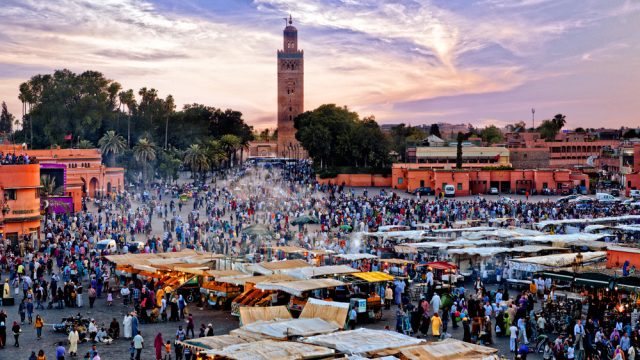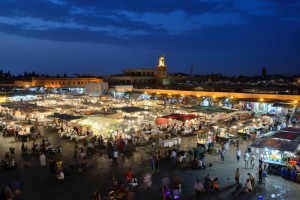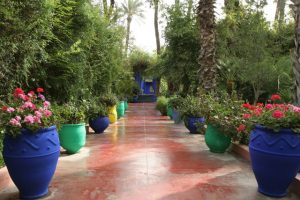Marrakech is the city most people think of when they conjure up images of traditional Morocco; there you’ll find snake charmers, fire breathers, and great street food everywhere you look. Outside the medina, in the new city, things are more orderly, but the city still pulses with the energy of a thousand chic bars, avant-garde galleries, stunning gardens, and architecturally significant monuments.
History and Orientation
The area that Morocco is situated in has been inhabited by Berber farmers since the Neolithic period, and the city was built by the Moroccan Berber empires in the Middle Ages. It displays cultural influences of various religious, ethnic and national groups who have dominated it through the centuries, including the Saadians, the Sufis, and the French. Although Morocco gained its independence from France in 1959, it’s still very popular with the French and many have second homes in Marrakech which they enjoy during winter getaways.
There are two parts of the city, the historical medina (old city) and the modern Ville Nouvelle (also known as the new city, or Gueliz). You should keep a map with you at all times when in the medina, as it is easy to get disoriented. There are 14 babs (arched gates) throughout the edge of the medina that you’ll eventually run into if you get lost. Once you find one, you can easily get out of the ancient quarter or head back in once you get your bearings. The wider streets of the Gueliz are easier to navigate and are generally all signposted. The medina is where you want to go to experience the Marrakech you often see in pictures: it’s chock full of old shops, narrow passageways, and faded architecture of yesteryear. The new city, while lacking some of the charming distinctions of the medina, is where many of the newer restaurants, brand-name shops and museums are located. To fully experience the old and new of the city, you definitely should check out both areas.
Attractions
Marrakech’s main square and center of activity, the Djemaa el-Fnaa, is always at the top of visitors’ to-do lists. Nearly 1,000 years old, the sounds, smells, and sights truly transport you to another era. Snake charmers, dancers, merchants, and touts pull you in every direction. The square comes to life at sunset and you’ll find food from all corners of the country. A new experience every time you visit, you could spend days (or years) here.
Once you’ve experienced the blazing intensity of the Djemaa el-Fnaa, venture off into the bustling souks, where you can shop for anything from delicious spices to beautifully crafted teapots. Just be sure to haggle, haggle, haggle. (For advice on how to do this, click here.)
Another nearby option to check out is the Koutoubia Mosque, named after the booksellers who used to be established there. Stop for awhile and admire the intricate architecture of the minaret. Stick around to catch the glow from the building as it lights up at night. This might be the best view you can get, because if you want to tour inside, you’ll only be allowed if you are Muslim.
About a five-minute walk away from the Djemaa el-Fnaa you’ll find the Dar Si Said Museum on Rue Riad Zitoun. It houses a large number of artifacts from across Morocco (mostly regional) including pottery, wood carvings and ancient weapons. With an entrance fee of only Dh 25, it’s definitely worth spending a few hours, especially if you are there in the summer trying to escape the hot sun.
If you’re looking for a bit of peace and quiet, head outside the medina into the new city and find the Majorelle Gardens (le Jardin Majorelle). It’s a great place to relax and is full of interesting palms and cacti. Inside, you’ll also find the Berber Museum. It doesn’t house that much, but if you aren’t planning an excursion elsewhere in Morocco, it’s worth going in order to gain insight into the Berber culture. The entrance fee for the Gardens is Dh 50 and Dh 25 for the museum.
Dining and nightlife
Morocco has a strong culinary tradition, and there’s no shortage of world-class eateries to choose from. From the intimate riad restaurants of the medina to the ultra-chic cafés of the Ville Nouvelle, there are plenty of places to eat and drink in Marrakech at all budget points.
To overlook the spectacle of Djemaa el Fna, grab a seat at one of the terrace restaurants bordering the square, such as Marrakchi. Sultry belly dancers inside compete for your attention amid the jovial street-fair atmosphere outside. For a place that could very easily become a tourist trap, the authentic Moroccan fare is actually quite impressive — the harissa soup in particular deserves a mention.
For a truly lavish Moroccan meal, book a table at celebrity chef Moha Fedal’s Dar Moha, a fine-dining experience favored by the discerning palates of celebs like Oprah Winfrey and Will Smith. The restaurant is a posh manse once home to the designer Balmain, a soothing and tranquil escape from the medina mayhem. He elevates traditional Moroccan flavors by introducing unexpected ingredients and methods: think seafood pastillas or couscous with foie gras.
For something that doesn’t stray too far from the traditional, consider booking a table at Al Fassia, in the Ville Nouvelle. This elegant female-run restaurant serves an endless array of traditional hot and cold mezze, and a wide variety of tagines.
Nightlife offerings throughout the sultry Red City are just as diverse as the culinary options, ranging from modern to old-world: the decadent Comptoir Darna and Jad Mahal live up to your most outrageous Arabian Nights fantasies, with extravagant decor and belly dancers galore; Sky Lounge at the Delano is pure Miami chic; Lotus Club has a retro, flapper vibe; and So is the ultimate mega-club, with a more low-key outdoor patio area for when the thumping base gets overbearing.
Where to Stay
Whether it’s in a riad or a traditional hotel, Marrakech is certainly not lacking on fantastic places to stay. Most of the riads are found within the medina, while the more modern, swank resorts and boutique hotels tend to be found in the new city.
The Sofitel Marrakech Palais Imperial is the place to go for pure pampering – if you have the budget to afford it. The products in the bathroom are made by Lanvin, and the beds and soft and cloud-like. There are four high-end restaurants in the premises, luxe shopping, a nightclub, and a spa. The décor is lavish without being gaudy, and locally inspired without being in-your-face. The Sofitel is also one of the best-located hotels in Marrakech; on one side are a slew of the city’s top clubs; on the other is the hectic medina.
Also on the high end is the sumptuous, sprawling rose-colored Kenzi Menara resort. The property is a supersized complex of interconnecting riads adorned with massive canvases featuring vignettes of everyday Moroccan life from centuries past, and the 231 spacious guestrooms have private patios or balconies overlooking acres of manicured gardens. The hotel’s pièce de résistance is the pool deck, which hosts one of the most bumping daytime scenes in Marrakech.
The charming Riyad el Cadi, located in a 300-year-old building in the labyrinthine medina, offers multiple tree-shaded courtyards, a plunge pool, numerous salons clad in faded Berber kilims, and wrought-iron balconies. The 14 rooms are uniquely appointed and each has its own charms. Here you can also arrange a private cooking class with a Moroccan chef.
Riad Kaiss (by Sans Souci) is a lower-priced option in the medina. The nine suites are simply decorated with quirky touches like a series of straw hats strung across the wall and the wall-to-wall-tiled bathroom offers a standalone tub. The property also offers a plunge pool, towering palms, and its crowning glory, a stunning roof terrace looking onto the green-tiled roof.
Excursions
It’s only a few hours from Marrakech to the Atlantic Coast and the ancient city of Essaouira, which has lured travelers for centuries. The city is part of the greater Marrakech economic region, and is where a lot of the city’s sea trade comes from. While here, climb the ancient walls of the fortress as waves crash against the rocky coast. Get lost in the old alleys and pop into small artisan shops. Some of the best seafood can be found here as well.
In the other direction is the Ourika Valley, set in the Great Atlas mountains just hours away from the city. It’s filled with olive groves, scenic outlooks, and local Berber residents who adhere to a traditional way of life. Several tour companies offer excursions which include a trip into a Berber village market, the waterfalls of Seti Fatma, and a mountain trek.
A few hours south of Marrakech, you’ll find Aït Benhaddou. The ancient citadel and city appears out of the desert and mountains like a mirage, and before you know it, you’re crossing sandbag steps over a river and have stepped into what seems like a dream. This location was also featured in films like Gladiator, Kingdom of Heaven, and more recently, Game of Thrones. Plan an afternoon visit when the sun on the mud structures is at its most dramatic. There are even a few guesthouses offering lodging if you can’t pull yourself away.
Getting There and Around
Menara International Airport (RAK) receives dozens of daily non-stop flights directly from European cities such as London, Paris and Madrid. If you’re flying from elsewhere, you’ll usually have to change planes in Casablanca. If you are flying from inside Morocco, Royal Air Maroc operates daily flights from Fez, Casablanca and several other cities.
The airport is just outside of the city, making for a quick ride into Marrakech. You can take the No 19 Airport express bus, which leaves the airport every 30 minutes throughout the day, or catch a taxi — just be sure to get a price quote up front for your destination.
Trains are an easy way to get to Marrakech from other points in the country. The national railway company operates an extensive network of trains which run several times a day between Marrakech and all major cities, including Fez, Oujda, Casablanca, Rabat, Meknes, and Tangier (which has both day and night trains).
Yet another way to get into Marrakech is by bus. The recommended inter-city bus companies are Supratours, CTM and Pullman du Sud. While other small operations exist, it’s recommended to use one of these three because they are the safest and most reliable.
Once in Morocco, renting a car is quite easy. The highway infrastructure is generally functioning, although prices can be exorbitant for weekly rentals.
Taxis are readily available and come in two forms: the petit taxi and the grand taxi. Petit taxis have a maximum of three passengers and have meters, while grand taxis (usually a Mercedes) don’t run meters and don’t have a limit on the amount of people inside. If taking a petit taxi, be sure they have change beforehand and don’t let them charge you for anything extra such as bags. If taking a grand taxi, discuss the final fee before you enter to avoid a mark-up in price.
Of course, getting around on foot is quite easy as well, just be sure not to get lost when walking around the medina (it’s pretty easy to do so). And carry water with you if you are out and about in the blazing summer months.
Practical Considerations
Location: Marrakech is the fourth largest city in Morocco and is located near the foothills of the Atlas mountains — a few hours from the Sahara desert. It’s approximately 327 km (203 miles) southwest of Rabat and 239 km (149 miles) south of Casablanca.
Weather: The city has a semi-arid climate with hot summers and mild winters. Temperatures can average as high as 38C (100F) in July to 19C (66F) in January.
Health and safety: Although pick-pocketing is common, keeping a tight grip on your valuables in crowded places is an easy way to avoid it. Western women often get excessive attention from men, particularly if walking alone. Just ignore it and do not make eye contact. Definitely be aware of scams from all sides when in Marrakech, from taxis trying to jack up your rates, to fake bellboys trying to charge you extra to carry your bags. Scammers are also prevalent in the Djemaa el-Fnaa, but fortunately many police officers are on patrol looking for ones who bother tourists.
Local customs: Women are advised to cover their shoulders and legs in public areas. Swim suits on men or women are acceptable only in beach or poolside locations. Also, when in mosques or other holy sites, women must cover their hair.
Money: The national currency is the dirham, abbreviated Dh. It’s best to change money once you enter the country, not before, as few banks overseas carry the currency. You can exchange money in a bureau de change, a bank or a hotel (most hotels will exchange at the same rate as banks and without charging commission). Most upmarket restaurants, shops and hotels or riads will accept credit and debit cards (just not American Express). Banks are plentiful, and ATMs can be found all over the city and in many hotels. The medina even has 20 ATMs.
Hospitals: Polyclinique du Sud, 2 Rue Yougoslavie, Gueliz (+212 4444 7999; Inb Tofail Hospital, Rue Abdelouahab Derraq (+212 4444 8011)
Emergency numbers:
- Fire Department & Ambulance: Dial 15
- Police: Dial 19






